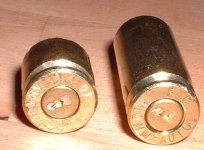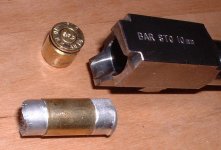Guffy, I understand your point, and I've gone over that a hundred times in my mind. Sure, you are correct that there will come a point in the cycle at which time the front will be caught and the back will still be loose, but there are problems with that idea. The brass, unless it was a lousy alloy, should have been able to stretch, rather than rip off in that jagged ring.
His rounds appeared to have a few hundredths inch extra space, looking at his chamber tests, and maybe that would be enough to let it tear out, but again, it doesn't seem right.
No matter what happened, the pressure would have been gone off of that brass before it extracted. The whole cycle of firing should have been completed before the barrel started to unlink.
His rounds appeared to have a few hundredths inch extra space, looking at his chamber tests, and maybe that would be enough to let it tear out, but again, it doesn't seem right.
No matter what happened, the pressure would have been gone off of that brass before it extracted. The whole cycle of firing should have been completed before the barrel started to unlink.


